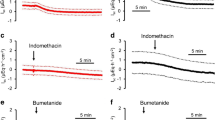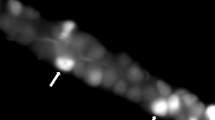Summary
The ionic permeability of the basolateral membrane ofNecturus gallbladder epithelium was studied with intracellular microelectrode techniques. After removal of most of the subepithelial tissue (to reduce unstirred layer thickness), impalements were performed from the serosal side, and ionic substitutions were made in the serosal solution while a microelectrode was kept in a cell. Thus, it was possible to obtain continuous (and reversible) records of transepithelial and cell membrane potentials and to measure intermittently the transepithelial resistance and the ratio of cell membrane resistances. From these data and the mean value of the equivalent resistance of the cell membranes in parallel (obtained from cable analysis in a different group of tissues), absolute cell membrane and shunt resistances and equivalent electromotive forces (emf's) were calculated. From the changes of basolateral membrane emf (E b ) produced by the substitutions, the conductance (G) and permeability (P) of the membrane for K, Cl and Na were estimated. Potassium-for-sodium substitutions produced large reductions of both cell membrane potentials, ofE b , and of the resistance of the basolateral membrane (R b ), indicating highG K andP K . Chloride substitution with isethionate or sulfate resulted in smaller changes of cell membrane potentials andE b and in no significant change ofR b , indicating small but measurable values ofG Cl andP Cl . Sodium substitutions with N-methyl-d-glucamine (NMDG) resulted in cell potential changes entirely attributable to the biionic potential produced in the shunt pathway (P Na >P NMDG ), and in no significant changes ofP b orE b , indicating thatG Na andP Na are undetectable. The question of the mechanism of Cl transport across the basolateral membrane was addressed by comparing the mean rate of transepithelial Cl transport (J net Cl ) and the predicted passive Cl flux across the basolateral membrane (from the membrane Cl conductance, potential, and Cl equilibrium potential). The conclusion is that only a very small fraction of the Cl flux across the basolateral membrane can be electrodiffusional. Since the paracellular Cl conductance is also too low to account forJ net Cl , these results suggest the presence of a neutral mechanism of Cl extrusion from the cells. This could be a NaCl pump, a downhill KCl transport mechanism, or a Cl−HCO3 exchange mechanism.
Similar content being viewed by others
References
Boulpaep, E.L. 1971. Electrophysiological properties of the proximal tubule: Importance of cellular and intercellular transport pathways.In: Electrophysiology of Epithelial Cells. G. Giebisch, editor. p. 91. Schattauer-Verlag, Stuttgart
Cremaschi, D., Hénin, S. 1975. Na+ and Cl− transepithelial routes in rabbit gallbladder. Tracer analysis of the transports.Pfluegers Arch. 361:33
Diamond, J.M. 1962. The mechanism of solute transport by the gallbladder.J. Physiol (London) 161:474
Diamond, J.M. 1964. Transport of salt and water in rabbit and guinea pig gallbladder.J. Gen. Physiol. 48:1
Dietschy, J.M., Moore, E.W. 1964. Diffusion potentials and potassium distribution across the gallbladder wall.J. Clin. Invest. 43:1551
Duffey, M.E., Turnheim, K., Frizzell, R.A., Schultz, S.G. 1978. Intracellular chloride activities in rabbit gallbladder: Direct evidence for the role of the sodium-gradient in energizing “uphill” chloride transport.J. Membrane Biol. 42:229
Frizzell, R.A., Dugas, M.C., Schultz, S.G. 1975. Sodium chloride transport by rabbit gallbladder. Direct evidence for a coupled NaCl influx process.J. Gen. Physiol. 65:769
Frömter, E. 1972. The route of passive ion movement through the epithelium ofNecturus gallbladder.J. Membrane Biol. 8:259
Frömter, E., Diamond, J.M. 1972. Route of passive ion permeation in epithelia.Nature New Biol. 235:9
Helman, S.I., Nagel, W. 1977. Microelectrode studies of frog skin. Effects of ouabain.Fed. Proc. 36:632a
Hénin, S., Cremaschi, D. 1975. Transcellular ion route in rabbit gallbladder. Electrical properties of the epithelial cells.Pfluegers Arch. 355:125
Hill, A.E., Hill, B.S. 1978a. Sucrose fluxes and junctional water flow acrossNecturus gallbladder epithelium.Proc. R. Soc. London B 200:163
Hill, B.S., Hill, A.E. 1978b. Fluid transfer byNecturus gallbladder epithelium as a function of osmolarity.Proc. R. Soc. London B 200:151
Lewis, S.A., Wills, N.K., Eaton, D.C. 1978. Basolateral membrane potential of a tight epithelium. Ionic diffusion and electrogenic pumps.J. Membrane Biol. 41:117
Machen, T.E., Diamond, J.M. 1969. An estimate of the salt concentration in the lateral intercellular spaces of rabbit gallbladder during maximal fluid transport.J. Membrane Biol. 1:194
Martin, D.W. 1974. The effect of the bicarbonate ion on the gallbladder salt pump.J. Membrane Biol. 18:219
Martin, D.W., Murphy, B. 1974. Carbamyl phosphate and glutamine stimulation of the gallbladder salt pump.J. Membrane Biol. 18:231
Moreno, J.H., Diamond, J.M. 1976. Cation permeation mechanism and cation selectivity in “tight junctions” of gallbladder epithelium.In: Membrane — A Series of Advances. G. Eisenman, editor. p. 383, Dekker, New York
Ogden, T.E., Citron, M.C., Pierantoni, R. 1978. The jet stream microbeveler: An inexpensive way to bevel ultrafine glass micropipettes.Science 201:469
Reuss, L. 1978. Effects of amphotericin B on the electrical properties ofNecturus gallbladder: Intracellular microelectrode studies.J. Membrane Biol. 41:65
Reuss, L. 1979. Ion conductances and electrochemical gradients across membranes of gallbladder epithelium.In: Membrane Transport Processes. Vol. 4. Cellular Mechanisms of Renal Tubular Ion Transport. E. Boulpaep, editor. Raven, New York (in press)
Reuss, L., Bello-Reuss, E., Grady, T.P. 1979. Effects of ouabain on fluid transport and electrical properties ofNecturus gallbladder. Evidence in favor of a neutral basolateral sodium transport mechanism.J. Gen. Physiol. (in press)
Reuss, L., Finn, A.L. 1975a. Electrical properties of the cellular transepithelial pathway inNecturus gallbladder. I. Circuit analysis and steady-state effects of mucosal solution ionic substitutions.J. Membrane Biol. 25:115
Reuss, L., Finn, A.L. 1975b. Electrical properties of the cellular transepithelial pathway inNecturus gallbladder. II. Ionic permeability of the apical cell membrane.J. Membrane Biol. 25:141
Reuss, L., Finn, A.L. 1977. Effects of luminal hyperosmolality on electrical pathways ofNecturus gallbladder.Am. J. Physiol. 232:C99
Rose, R.C. 1978. Electrolyte absorption by gallbladders: Models of transport.Life Sci. 23:1517
Rose, R.C., Nahrwold, D.L. 1976. Electrolyte transport by gallbladders of rabbit and guinea pig: Effect of amphotericin B and evidence of rheogenic Na transport.J. Membrane Biol. 29:1
Schafer, J.A., Patlak, C.S., Andreoli, T.E. 1975. A component of fluid absorption linked to passive ion flows in the superficial pars recta.J. Gen. Physiol. 66:445
Schultz, S.G. 1972. Electrical potential differences and electromotive forces in epithelial tissues.J. Gen. Physiol. 59:794
Spring, K.R., Kimura, G. 1978. Chloride reabsorption by renal proximal tubules ofNecturus.J. Membrane Biol. 38:233
Suzuki, K., Frömter, E. 1977. The potential and resistence profile ofNecturus gallbladder cells.Pfluegers Arch. 371:109
Van Os, G.H., Slegers, J.F.G. 1975. The electrical potential profile of gallbladder epithelium.J. Membrane Biol. 24:341
Wheeler, H.O. 1963. Transport of electrolytes and water across wall of rabbit gallbladder.Am. J. Physiol. 205:427
Whittembury, G. 1971. Relationship between sodium extrusion and electrical potentials in kidney cells.In: Electrophysiology of Epithelial Cells. G. Giebisch, editor. p. 153. Schattauer-Verlag, Stuttgart
Wright, E.M., Smulders, A.P., Tormey, J.Mc.D. 1972. The role of the lateral intercellular spaces and solute polarization effects in the passive flow of water across the rabbit gallbladder.J. Membrane Biol. 7:198
Zeuthen, T. 1978. Intracellular gradients of ion activities in the epithelial cells of theNecturus gallbladder recorded with ion-selective microelectrodes.J. Membrane Biol. 39:185
Author information
Authors and Affiliations
Rights and permissions
About this article
Cite this article
Reuss, L. Electrical properties of the cellular transepithelial pathway inNecturus gallbladder: III. Ionic permeability of the basolateral cell membrane. J. Membrain Biol. 47, 239–259 (1979). https://doi.org/10.1007/BF01869080
Received:
Revised:
Issue Date:
DOI: https://doi.org/10.1007/BF01869080




